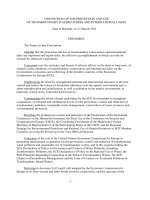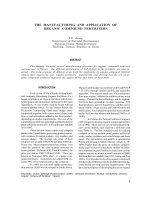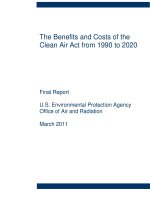hydrogen, the chemistry and manufacture of
Bạn đang xem bản rút gọn của tài liệu. Xem và tải ngay bản đầy đủ của tài liệu tại đây (1.4 MB, 159 trang )
THE
IHEMISTRY AND MANUFACTURE
OF
HTDROGEN
BY
P.
LlTHERLAND TEED
\R
is
MjMlNINC* AND METALLURGY), A I M M
MAJOR, KAI-,
LONDQ.
EDWARD 1
1919DEDICATECBTO
M^ITLAND.JLM.G,
D.S.O., R.A.F
ANI>
. A-F.C, R.AF.
DEFACE.
aiH&nal requirements are perhaps the
greatest, it i3 t&sJUfrortl^ that our contribution to the
technology o$%vMfe"en •& probably the least of any
of the Qreat* FflwW; so, should it happen that this
work in any way stimulates interest, resulting in
further improvement in the technology of the subject,
the author will feel himself more than amply rewarded
The author would like to express his thanks to
the Director of Airship Production for permission to
publish this book, and to Major L. Rutty, R.A.F.,
for many helpful suggestions in the compilation of
the text and assistance in correcting the proofs.
P.
L. T
EYNSKORD, KENT
CHAP. PAGE
I. HYDROGEN—ITS USES—DISCOVERY, AND OCCURRENCE
IN
NATURE I
II THE CHEMICAL PROPERTIES OF HYDROGEN 9
III THE MANUFACTURE OF HYDROGEN CHEMICAL
METHODS . 39
IV THE MANUFACTURE OF HYDROGEN. CHEMICO-PHYSICAL
METHODS 113
V THE MANUFACTURE OF HYDROGEN. PHYSICAL METHODS 126
APPENDIX, PHYSICAL CONSTANTS . 145
HYDROGEN—ITS USES—DISCOVERY, AND OCCUR-
RENCE IN NATURE.
The Uses of Hydrogen.—The commercial pro-
duction of hydrogen has received a great stimulus dur-
ing the last few years owing to its being required for
industrial and war purposes in quantities never previously
anticipated.
The discoveries of M. Sabatier with regard to the
conversion of olein and other unsaturated fats and their
corresponding acids into stearin or stearic acid have
created an enormous demand for hydrogen in every in-
dustrial country ;
1
the synthetic production of ammonia
by the Haber process has produced another industry
with great hydrogen requirements, while the Great War
has,
through the development of the kite balloon and
airship, made requirements for hydrogen in excess of
the two previously mentioned industries combined.
The increase in hydrogen production has modified
the older processes by which it was made, and has also
led to the invention of new processes, with the result
that the cost of production has decreased and will prob-
ably continue to decrease, thus allowing of its employ-
ment in yet new industries.
1
The weight of oil hardened by mean&xSBk*.
fliQKen
in Europe
in 1914 probably exceeded 250,000 tons.
I
2 HYDROGEN
The Discovery of Hydrogen.—The discovery of
hydrogen should be attributed to Turquet de Mayerne,
1
who in 1650 obtained, by the action of dilute sulphuric
acid on iron, a gas, or " inflammable air,", which we now
know to have been hydrogen.
Turquet de Mayerne recognised thergpf he obtained
as a distinct substance. Robert Boyle
9
made some
experiments with it, but many of its more important
properties were not discovered until Cavendish's investi-
gations,
8
beginning in 1766; while the actual name
"Hydrogen," meaning "water former," was given to
the gas by Lavoisier, who may be regarded as the first
philosopher to recognise its elemental nature.
Occurrence in Nature,
Hydrogen occurs in small quantities in Nature in
the uncombined state. It is found in a state of con-
densation in many rocks and in some specimens of
meteoric iron. It is present in the gaseous discharges
from oil and gas wells and volcanoes, and is also a con-
stituent to a very minute extent of the atmosphere.
Hydrogen in the uncombined state exists in enor-
mous masses upon the sun, and is present in the
"prominences" observed in solar eclipses, while by
optical means it may also be detected in many stars and
nebulae.
1
Paracelsus, in a similar experiment in the sixteenth century,
obtained the same gas, but failed to recognise it as a distinct sub-
stance.
2
" New Experiments touching the Relation between Flame and
Air," by the Hon. Robert Boyle, 1672.
8
James Wat^^discoverer of the steam engine, did many similar
experirffl^^^^^^^game time, but his interpretation of his results
Was
r^jjffi^^y^^^fel
OCCURRENCE IN NATURE 3
In. the combined state hydrogen is extremely abun-
dant. It is present to the extent of one part in nine (by
weight) in water, and is a constituent of all acids and
most organic compounds.
In Rocks.—In a state of "occlusion," or molecular
condensation, hydrogen is to be found in most igneous
rocks in association with other gases, the total volume
of occluded gases being on the average about 4*5 times
the volume of the rock.
The following analyses of Sir William Tilden
1
give
the composition of the occluded gases in several rocks
from different parts of the world :—
Granite. Skye . . 23-6 6-45 303 5-13 6r68
Gabbro Lizard . 5 5 2-16 2-03 1-90 88*42
Pyroxene Ceylon . 7 72
8*o6
56 ri6 12*49
gneiss.
Gneiss . Senngpatam 31*62 5-36 51 -56 6193
Basalt . Antrim . 32*08 2008 10*00
I*6I
36*15
In Meteoric Iron
#
—An examination of certain
meteoric irons, made by Sir William Ramsay and Dr.
Travers,
3
showed that these contained occluded gas, and
that this gas was hydrogen :—
D
MetSrite.°
f
Weight Taken. Hydrogen Evolved.
Toluca . . 1 grm. 2*8 c.c
Charca . . ,, "28 „
Rancho de la Pila „ *57 „
1(
'Proc.
Roy. Soc," 1897.
4 HYDROGEN
Observing that meteoric iron contains occluded
hydrogen, it is interesting to note that the examination
of steel shows that it also possesses this property of con-
densing gases. Steel of the following composition—
Per Cent
Combined carbon . . . . *8io
Silicon "o8o
Manganese . 050
Sulphur '028
Phosphorus . . . . -019
Iron (by difference) .
9 9
"013
IOO'OOO
in pieces 6xixi cm. was heated (ultimate temperature
979
0
C.) for ten days in vacuo and the gases evolved
analysed, with the result that they were found to have
the following composition :—
Per Cent
by Volume.
Hydrogen . 52*00
Carbon monoxide . 45'52
„ dioxide . . 1 68
Methane . . . 72
Nitrogen . 08
IOO'OO
The total weight of steel was 69*31 grammes, while
the total volume of gas evolved was 19*86 cc.
1
An examination of a defective Admiralty bronze
casting showed that there was an appreciable quantity
of occluded gas in it, containing J'6 per cent, of hydro-
gen by volume
2
1
" GasesOccluded in Steel," by T. Baker, Iron and Steel Institute,
"Carnegie Scholarship Memoirs," vol. 1., 1909.
2
" Ast4gyf|»|ff1aon on Unsound Castings of Admiralty Bronze,
by H^&LiimfflHIfcej: and C. F. Elam, Inst. of Metals, 1918.
OCCURRENCE IN NATURE
5
In Discharge from Oil and Gas Wells,—The
gas discharged from gas and oil wells contains small
quantities of hydrogen, as will be seen from the follow-
ing analyses of natural gas discharges in Pennsylvania,
West Virginia, Ohio, Indiana, and Kansas.
AVERAGE COMPOSITION By VOLUME
1
Pa.
&
W. Va. Ohio
&
Ind. Kansas
Hydrogen
Carbon dioxide
Sulphuretted hydrogen .
Oxygen
Carbon monoxide
Methane
Other hydrocarbons
Nitrogen
'10
<0
5
oo
trace
40
80-85
14 00
4 60
1-50
•20
•15
•15
"5°
93 60
.30
3'60
•00
3°
•00
•00
1'00
93'
6
5
•25
480
In Gases from Volcanoes.
2
—The nature of the
gases discharged from volcanoes has been most care-
fully studied from about the middle of the last century,
with the result that the chemical composition of the gas
discharged has been determined at many different vol-
canoes, and at different times at the same volcano.
From these investigations it would appear that in the
more violent discharges there are very considerable
amounts of hydrogen, while in the more placid eruptions
there is little gas of any description, except steam,
generally accompanied by water containing mineral
salts.
^SA. Geological Survey, "Mineral Resources of U
S.A.,"
1909,
2, 297.
2
For further information on this subject-^see F. W. Clarke's
" The Data of Geochemistry," U.S G.S Bull, tufi
6 HYDROGEN
Below are given analyses of volcanic gas from differ-
ent parts of the world by different authorities :—
From a group of fumaroles at Reykjalidh, Ice-
land
1
:—
Hydrogen . 25*14
Oxygen —
Nitrogen • o"7
2
Carbon dioxide • 5°'°°
Sulphur dioxide —
Sulphuretted hydrogen . . .24*12
From afumarole on Mont Pelee, Martinique*:—
Hydrogen
8
f
i2
Oxygen 13 67
Nitrogen . . 54"94
Carbon dioxide . . . 15 "38
Sulphur dioxide. —
Carbon monoxide i"6o
Sulphuretted hydrogen . . —
Methane . . . 5'46
Argon . . -71
99-88
From Kilattea
%
:—
Hydrogen 10*2
Oxygen . —
Nitrogen
II*8
Carbon dioxide 73 9
„ monoxide 4-0
Sulphur dioxide. . —
99'9
1
R. W Bunsen, " Annales Chim. Phys.," 3rd ser., vol. 38, 1853
2
H.
Moissan^^Comptes Rend.," vol. 135, 1902.
8
A.
L. Day*andE. S Shepherd, "Bull. Geol. Soc. America,"
vol.
24,
OCCURRENCE IN NATURE 7
From Santonn
1
:—
Hydrogen . 29 43
Oxygen . -32
Nitrogen 32*97
Carbon dioxide . . . . . . 36 43
Carbon monoxide . —
Methane . -86
Sulphuretted hydrogen —
100 00
In Clays.—Not only is hydrogen present in most
igneous rocks, but it is to be found to a small extent
in some clays. Sir William Crooks, O.M., F.R.S.,
was kind enough to investigate for the author the
gases occluded in the celebrated " Blue Ground"—
a clay in which the Kimberley diamonds are found.
This clay was found to contain gas composed of 82
per cent, of carbon dioxide, the bulk of the residue
being oxygen and nitrogen, with detectable traces of
hydrogen.
In Air*—As is not surprising, hydrogen is present
in the atmosphere to a very small extent, as will be
seen from the following analysis of air under average
conditions. It is doubtless derived from the sources
already mentioned, and also from the decay of organic
matter containing hydrogen
The following represents the average composition of
normal air:—
Volumes per 1000.
Nitrogen . 769 500
Oxygen . . . . 206*594
Aqueous vapour . i4"ooo
1
F Fouque, " Santonn et ses eruptions," Pans, 1879.
HYDROGEN
Volumes per iooo.
Argon 9"35
8
Carbon dioxide "336
Hydrogen '19
Ammonia . *oo8
Ozone "0015
Nitric acid . . -0005
Neon "oi
Helium "ooi
Krypton *ooi
Xenon 00005
THE CHEMICAL PROPERTIES OF HYDROGEN.
HYDROGEN
in the free state has a capability of enter-
ing into combination with a large variety of substances,
forming chemical compounds, while hydrogen in the
combined state reacts with many other chemical com-
pounds, forming new compounds.
Reaction of Hydrogen with Oxygen in the Free
State*
By far the most important chemical reaction of hy-
drogen is undoubtedly that which it enters into with
oxygen. When hydrogen is mixed with oxygen and
the temperature of the mixed gases raised, they com-
bine with explosive violence, producing steam. This
reaction may be expressed by the following equation :—
2H
2
+ O
2
=» 2H
2
O.
If a stream of hydrogen issues into air and a light is
applied to it, it burns (in accordance with the above
equation) with an almost non-luminous flame. (This
reaction is, of course, reversible, i.e. a stream of air
would burn in the same way in an atmosphere of hy-
drogen.) It was discovered by Frankland
1
that while
at atmospheric pressure the flame of hydrogen burning
in oxygen is almost non-luminous if the pressure is
1
" Proc. Royal Soc ," vol. xvi, p. 419.
(9)
io HYDROGEN
increased to two atmospheres the flame is strongly
luminous.
The combination of oxygen and hydrogen is most
violent if the two gases are present in the relative
quantities given in the equation, viz. two volumes of
hydrogen and one of oxygen. If one or other of the
gases is in excess of these quantities the violence of the
reaction is reduced and the quantity of the gas in excess
of that required by the equation remains as a residue.
When one gas is enormously in excess of the other
a condition may arise in which the dilution is so great
that on sparking the mixture no reaction takes place.
1
Mixtures of air and hydrogen in which the air is under
20 per cent. (i.e. under 4 per cent, of oxygen) of the
total volume behave in this way.
This point is of importance in airships, as, providing
the purity of the hydrogen in the envelope is above
80 per cent by volume, an internal spark in the envelope
will not cause an explosion, but if the quantity of
hydrogen by volume falls below this amount there is a
risk of explosion ; hence the procedure of deflating
airships when the purity has dropped to 80 per cent,
hydrogen by volume.
The Temperature of Ignition of Hydrogen and
Oxygen,—When the two gases are mixed in the pro-
portion of two volumes of hydrogen and one volume
of oxygen it has been found that the temperature of
the mixed gases must be raised to about 580
0
C.
2
1
Schoop states that when either gas contains 6 to 8 per cent,
of the other it is explosive.
a
Victor Meyer, "Berichte," No. 16, 1893, gives the temperature
of violent reaction as 612-15° C. Gautier and Helier, "Comptes
Rend.," 125, 271, 1897, gwe about 550
0
C
CHEMICAL PROPERTIES n
before explosion takes place. However, Professor
Baker
a
has shown that, if the two gases are not only
perfectly pure but also perfectly dry (dried by being
kept in contact for as long as three weeks with anhydrous
phosphoric acid) at the temperature of iooo
0
C, they
do not combine, but even in this dry condition they
will explode with an electric spark.
2
This phenomenon
is of great interest, and opens a wide field of philosophic
speculation, but the conditions of purity and dryness are
such that this high temperature of ignition can never
be attained under commercial conditions.
Professor Baker has also shown that, when a mixture
of ordinary hydrogen and oxygen is exposed to the in-
fluence of strong sunlight, the two gases very slowly
react, with the production of water in minute quan-
tities.
In the experiment by which Professor Baker made
this discovery he placed a mixture of these two gases in
a state of great purity but not of absolute dryness (in
the ratio of two volumes of hydrogen and one of
oxygen) in a hard glass tube closed at one end and
sealed at the other by mercury. This tube was exposed
outside a south window for four months, from September
to December, at the end of which time it was found,
after due correction for temperature and pressure, that
the mixture of the two gases had contracted by ^ of its
original volume
3
by the formation of water. A similar
experiment with the gases in an exceptionally dry state,
lf
'Jour. Chem Soc.," April, 1902.
2
Dixon, "Jour. Chem. Soc," vols. 97 and 98.
3
The volume of the resulting water is almost negligible, as
one volume of hydrogen and oxygen in the ratio stated produces
only "006 volume (approximately) of water.
12 HYDROGEN
but otherwise under exactly similar conditions, showed
no such contraction.
Whether the union of hydrogen with the infiltrating
oxygen of the atmosphere takes place in airship envel-
opes,
which are comparatively transparent, has not been
determined, but since in airship practice there is never
more than 4 per cent, of oxygen in the envelope, it is
1
!>530
I
:525
520
"rsi
60
100
160 200 Z5O 300
Volumes
jofOjg
to
100
Volumes offy
FIG. I.
350 400
to be anticipated that such action, if it took place, would
of necessity be relatively slower.
The temperature of ignition of varying mixtures of
hydrogen and oxygen has been most carefully studied
by Professor H. B. Dixon,
1
who, besides much very in-
genious apparatus, employed the cinematograph for ob-
taining conclusive evidence of the conditions prevailing
during explosion.
1(
'Jour. Chem Soc," vols. 97 and 98, and vols 99 and 100
CHEMICAL PROPERTIES 13
By means of adiabatic compression, the temperature
of ignition of different mixtures of hydrogen and oxygen
was determined, with results which may be seen in
Fig. 1. From a study of this curve it will be noticed
that the most easily ignited mixture is not one in which
the proportion of hydrogen to oxygen is as two to one,
as might perhaps be expected, but when the ratio is
one volume of hydrogen to four of oxygen.
IGNITION TEMPERATURES OF HYDROGEN AND OXYGEN MIXTURES.
(As determined by
Prof.
H B Dixon, M.A., F R.S.)
[Ignition by Adiabatic Compression)
Composition of Mixture. Ignition
By Volume. Temperature
Oxygen. Hydrogen. ° Centigrade.
33"33
40
5o
100
150
200
250
300
350
400
100
557
542
536
53°
525
520
5i6
512
509
507
The temperature of ignition of a mixture fired by
adiabatic compression is lower than when the same
mixture is fired by being heated in a glass or silica tube
at atmospheric pressure. Professor H B. Dixon in a
private communication to the author states that he found
the ignition temperature of electrolytic gas under the
latter conditions to be 580" C.
i
4
HYDROGEN
Besides studying the temperature of ignition of
various gaseous mixtures Professor H. B. Dixon in-
vestigated the nature of explosions
1
and found that
Berthelot's conception of an explosion as being an ad-
vancing locus of high pressure and of rapid chemical
change, which he described as "l'onde explosive," was
fundamentally correct.
Without going into detail with regard to this very
interesting subject, it may be stated that " the velocity of
the explosion wave in a gaseous mixture is nearly equal
to the velocity of sound in the burning gases ".
While this statement does not satisfy all cases of
gaseous explosion, it may be regarded as fundamentally
correct, exceptions to the rule being capable of explana-
tion on the basis of undoubted secondary reactions.
On the basis of this relationship between the velocity
of sound in the burning gases and the velocity of ex-
plosion, Professor H. B. Dixon calculated the velocity
of the explosion wave in certain gaseous mixtures and
also determined it experimentally, with the results given
below:—
Velocity of Explosion Wave in
Metres per sec
Gas Mixture.
8H
2
+ O
a
H
2
+ 3O2
Calculated
3554
1740
Found
3535
1712
While it has been said that the temperature of igni-
1
"The Rate of Explosion in Gases," by H. B. Dixon, Bakenan
Lecture, Phil. Trans. Royal Society, 1893
CHEMICAL PROPERTIES 15
tion of hydrogen and oxygen in their most readily
ignited proportions must be at some point at least 500°
C. in the mixture of the gases, this statement requires
modification in that, though it is perfectly true in the case
of a mixture of the gases contained in glass or non-
porous vessels, in the presence of certain substances of
a porous nature this temperature of ignition is greatly
reduced. This is particularly so in the case of platinum
in a spongy condition. If a piece of spongy platinum
is introduced at ordinary atmospheric temperature into
an explosive mixture of hydrogen and oxygen, the
platinum is observed to glow and, an explosion almost
immediately takes place. This property is more marked
if the platinum is in the spongy condition, but it is
equally true if it is in the form of wire or foil.
There is no complete explanation of this phenomenon,
but it has been observed that certain substances possess
the property of absorbing many times their own volume
of different gases, and that these absorbed gases possess
a greatly increased chemical activity over their normal
activity at the same temperature. Neuman and Strientz
1
found that one volume of various metals in a fine state
of division is capable of absorbing the following amounts
of hydrogen :—
Palladium black . . . 502*35 volumes.
Platinum sponge 49*3
Gold . 46-3
Iron . . . 19*17
Nickel i7'57
Copper . . 4-5
Aluminium . 2*72
Lead. -15
1
"Zeitschrift fur analytiscbe cheraie," vol. 32.
16 HYDROGEN
This property of certain substances, without them-
selves undergoing chemical change,
1
of being able to
impart increased chemical activity to the gases they
absorb is not confined to the metals, but is possessed by
charcoal (particularly animal charcoal), magnesite brick,
and probably to some extent by all porous substances.
It is a subject of very great interest, and in many cases
of practical importance
2
which is now becoming a sub-
division of Physical Chemistry, under the name of " Sur-
face Energy ".
The Temperature Produced by the Ignition of
Hydrogen and Oxygen.—In the previous paragraph
the temperature at which the ignition of hydrogen and
oxygen begins has been given, and now the temperature
which the flame reaches will be considered.
Bunsen determined the temperature of the flame
produced to be :—
Flame of hydrogen burning in air . 2024
0
C.
„ „ oxygen . . 2844
0
C.
A later determination by Fe"ry ("Comptes Rend,"
1902,
134, 1201) gives the values 1900° C. and 2420° C.
respectively, while Bauer
(ibid.,
1909, 148, 1756) ob-
tained figures for hydrogen burning in oxygen varying
from 2200
0
C. to 2300
0
C, according to the proportion of
oxygen present.
The reason that the flame of hydrogen burning in
oxygen is hotter than the flame produced in air is due
1
It is contended by Troost and Hautefeuille that in the case of
palladium the absorption of the hydrogen is chemical and not
physical, palladium hydride (Pd
2
H) being formed.
2
The Bonecourt flameless boiler depends on the surface energy
of magnesite brick.
CHEMICAL PROPERTIES 17
to the fact that the speed of burning in oxygen is greater
than in air, because of the absence of any dilution, and
also because the nitrogen and other inert constituents
in the air are themselves heated at the expense of the
flame temperature.
1
The calculated value for the flame temperature of
hydrogen burning in air, assuming that the heat of
reaction is distributed among the inert constituents of
the air, is 1970
0
C. (Le Chatelier), and this agrees ap-
proximately with the above figures of 202 4
0
C. and
1900
0
C.
A comparison between the flame temperature of
hydrogen and other gases burning in air is given in the
following table :—
Hydrogen
2
. . . i9oo°C.
Acetylene
3
. . . 2548°C
Alcohol
2
1705° C
Carbon Monoxide
4
. . 2ioo°C
The Quantity of Heat Produced by Burning
Hydrogen.—The temperature of ignition and the flame
temperature of hydrogen have already been considered.
It now only remains for the quantity of heat produced
by a given weight of hydrogen to be considered in
comparison with some other gases combustible in air.
1
In the case of Zeppelin airships brought down in flames, it is
not surprising that considerable amounts of molten metal have been
found in the locality, observing that the melting point of aluminium
is 657
0
C, copper 1087
0
C.
2
Fery, le
3
Fery, /
c.
The temperature of acetylene burning in oxygen is
about 4000
0
C, but this arises from circumstances not present in the
case of hydrogen flames
4
Le Chatelier.
2
18 HYDROGEN
i lb of hydrogen on combustion gives 62,100 B.T U
x
„ marsh gas „ „ „ 24,020 „
,, benzene „ ,, ,, 18,090 ,,
„ carbon monoxide „ „ 4,380 „
Reactions of Hydrogen with Oxygen in the Com*
bined State*
So far the reaction of hydrogen and oxygen has
only been considered when both are in the gaseous
form. However, such is the attraction of hydrogen
for oxygen that when the latter is in combination
with some other element the hydrogen will gener-
ally combine with the oxygen, forming water and
leaving the substance formerly in combination with the
oxygen in a partially or wholly reduced state. Thus,
oxides of such metals as iron, nickel, cobalt, tin, and lead
are reduced to the metallic state by heating in an at-
mosphere of hydrogen.
Thus:—
(1) FeaOa + 3H2 - 2Fe + 3H
2
O
(2) NiO + H
2
- Ni + H
a
O
(3) CoO + H
2
= Co + H
3
O
(4) SnO
a
+ 2H
2
- Sn + 2H
a
O
(5) PbO + H
a
- Pb + H
2
O
The temperature at which the reduction by the
hydrogen takes place varies with the different oxides
and also with the same oxide, depending on its physical
condition. " Crystalline haematite," as the natural ferric
oxide is called, requires to be at a red heat (about 500°
C.) before reduction begins to take place, while if iron
is precipitated from one of its salts (as ferric hydrate by
1
The latent heat of the steam produced is included in the heat
units of fuels containing hydrogen.









